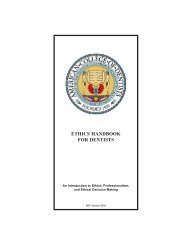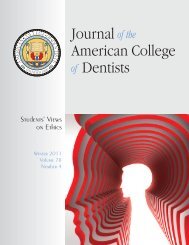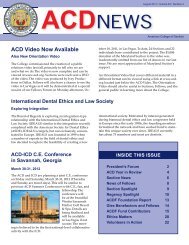JACD 71-4 - American College of Dentists
JACD 71-4 - American College of Dentists
JACD 71-4 - American College of Dentists
- No tags were found...
You also want an ePaper? Increase the reach of your titles
YUMPU automatically turns print PDFs into web optimized ePapers that Google loves.
Leadership<br />
60<br />
Pr<strong>of</strong>essions Defined<br />
A pr<strong>of</strong>ession is a community <strong>of</strong> individuals<br />
who advance the personal interests <strong>of</strong><br />
individual clients in a trusting relationship.<br />
There are five components in this<br />
definition, as identified in Table 1.<br />
Pr<strong>of</strong>essionals form a community<br />
<strong>of</strong> individual practitioners who must<br />
simultaneously meet standards set by<br />
their customers, themselves, and their<br />
pr<strong>of</strong>essional peers. It is obvious that<br />
dentists work to advance their patients’<br />
and their own interests at the same<br />
time. Sometimes, they are altruistic and<br />
sometimes they do pro bono work to<br />
enhance their reputation or the image<br />
<strong>of</strong> the pr<strong>of</strong>ession. The public expects<br />
pr<strong>of</strong>essionals to charge sufficiently high<br />
fees in general so that no single interaction<br />
with a patient or client is dominated<br />
by financial interests.<br />
Pr<strong>of</strong>essionals work for each other in<br />
the sense that the good that each does<br />
individually shines on behalf <strong>of</strong> the<br />
pr<strong>of</strong>ession as a whole and vice versa.<br />
Pr<strong>of</strong>essionals tend not to work for companies,<br />
organizations, bureaucracies,<br />
and others who <strong>of</strong>fer employment for a<br />
salary. Although there are employed<br />
pr<strong>of</strong>essionals, there are no examples<br />
where pr<strong>of</strong>essional employees enjoy a<br />
higher status than self-employed pr<strong>of</strong>essionals<br />
performing the same work.<br />
Pr<strong>of</strong>essionals have individual clients.<br />
They do custom work. True, a lawyer<br />
may represent a Fortune 500 company<br />
Table 1. The Five Characteristics <strong>of</strong> a Pr<strong>of</strong>essional<br />
that employs thousands, but he or she<br />
must represent that company in a<br />
unique fashion. This makes the high<br />
emphasis on diagnosis a seminal feature<br />
<strong>of</strong> the pr<strong>of</strong>essions and is part <strong>of</strong> the<br />
reason it is undercompensated. In any<br />
pr<strong>of</strong>ession, those who treat a generalized<br />
or group clientele have lowered status<br />
and pr<strong>of</strong>essions that deal with mass<br />
interactions—such as teachers or<br />
journalists—tend to rank lower on the<br />
hierarchy <strong>of</strong> pr<strong>of</strong>essions.<br />
Pr<strong>of</strong>essionals also deal in private and<br />
personal matters. We go to the lawyer<br />
when our finances or legal status is<br />
threatened. We go to the physician<br />
when our health is compromised. When<br />
our soul is hurting we seek the advice <strong>of</strong><br />
clergy. In all cases, we are trying to recover<br />
a full sense <strong>of</strong> who we are. We expect to be<br />
treated with dignity and confidentiality,<br />
because we are not acquiring something,<br />
we are being changed. The same is true<br />
to a lesser extent with accountants,<br />
teachers, or other advisors. It is certainly<br />
not the case with police <strong>of</strong>ficers or<br />
beauticians.<br />
Pr<strong>of</strong>essionals work as agents to<br />
advance the interests <strong>of</strong> their patients<br />
and clients. They do not <strong>of</strong>fer a menu <strong>of</strong><br />
transactions; the whole patient or client<br />
is the pr<strong>of</strong>essional’s concern. This is a<br />
different kind <strong>of</strong> economic transaction<br />
from buying a cell phone or having<br />
one’s toilet repaired. The pr<strong>of</strong>essional is<br />
paid for doing the best he or she can<br />
according to the conventions <strong>of</strong> the<br />
Community <strong>of</strong> practitioners who simultaneously work for themselves, customers, and peers<br />
Help patients and clients who are individuals making their own personal choices<br />
Serve private and personal needs <strong>of</strong> customers seeking wholeness<br />
Work as agents, on behalf <strong>of</strong> customers instead <strong>of</strong> transacting services<br />
Function in a relationship <strong>of</strong> trust<br />
pr<strong>of</strong>ession. Pr<strong>of</strong>essionals are not paid for<br />
results (some lawyers at the very lowest<br />
end <strong>of</strong> that pr<strong>of</strong>essional scale to the<br />
contrary); they are paid for prudent<br />
advice and action.<br />
Although it is true that pr<strong>of</strong>essions<br />
create monopolies, they are not restricted<br />
by market transactions in the same sense<br />
that the sewer company has a monopoly.<br />
They are monopolies on who can serve<br />
as an agent for various actions on behalf<br />
<strong>of</strong> their clients. There is no product that<br />
is exchanged and the rules <strong>of</strong> supply and<br />
demand are inappropriate in the sense<br />
that the demand for health, justice, spiritual<br />
well-being, and other benefits<br />
provided by pr<strong>of</strong>essionals is essentially<br />
open-ended. It is wrong to assume that<br />
the economics <strong>of</strong> goods and services<br />
apply to the relationship between pr<strong>of</strong>essionals<br />
and their clients. The assumed<br />
antithesis between commercialism and<br />
pr<strong>of</strong>essionalism is bogus.<br />
The fundamental relationship<br />
between pr<strong>of</strong>essionals and their clients<br />
is one <strong>of</strong> trust. This one factor may well<br />
serve as the most useful index for<br />
identifying pr<strong>of</strong>essionals and for ranking<br />
pr<strong>of</strong>essions in a hierarchy. (See Table 2<br />
for the results <strong>of</strong> the most recent Gallup<br />
survey on trust in pr<strong>of</strong>essions.) Because<br />
the nature <strong>of</strong> pr<strong>of</strong>essional services is<br />
both personal, individual, and beyond<br />
the client’s ability to evaluate, the relationship<br />
between pr<strong>of</strong>essional and client<br />
is inherently asymmetric. A patient, for<br />
example, is not an individual who has<br />
2005 Volume <strong>71</strong>, Number 4





